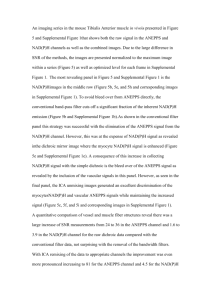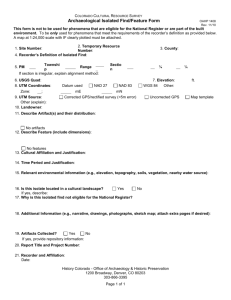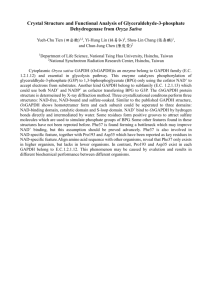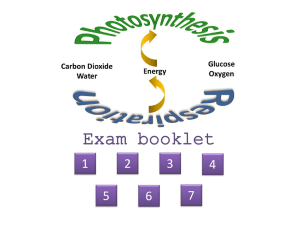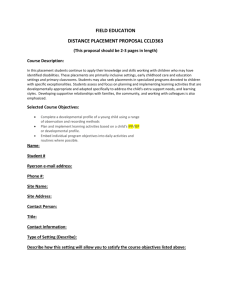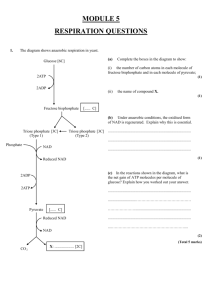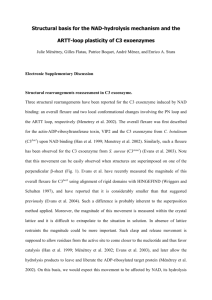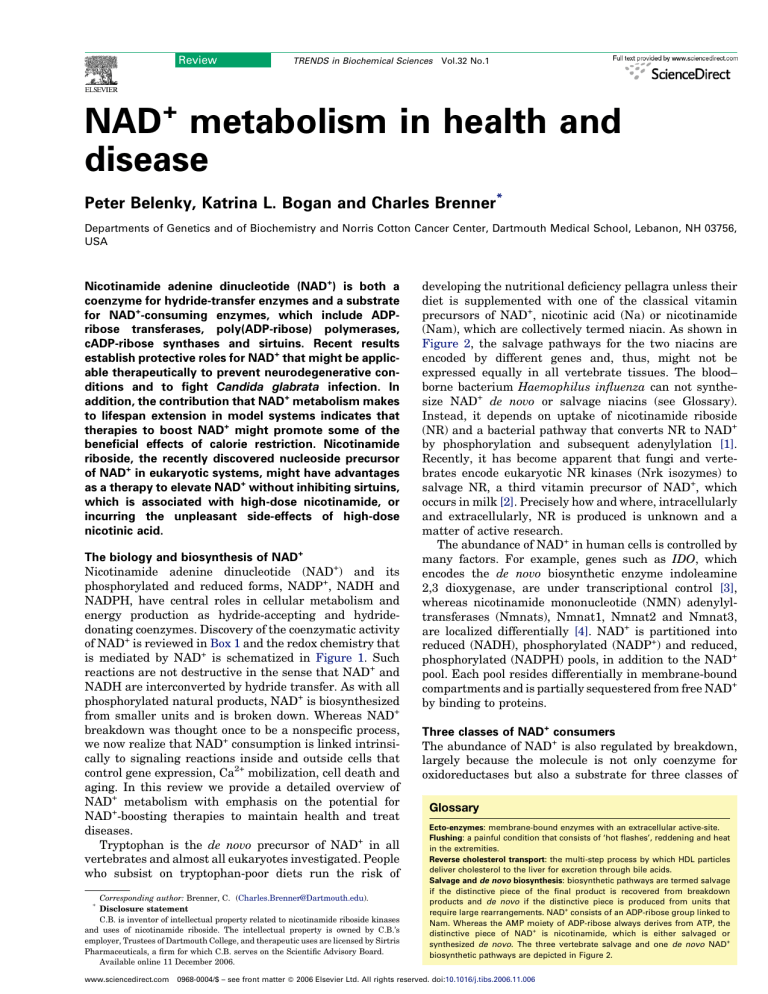
Review
TRENDS in Biochemical Sciences
Vol.32 No.1
NAD+ metabolism in health and
disease
Peter Belenky, Katrina L. Bogan and Charles Brenner*
Departments of Genetics and of Biochemistry and Norris Cotton Cancer Center, Dartmouth Medical School, Lebanon, NH 03756,
USA
Nicotinamide adenine dinucleotide (NAD+) is both a
coenzyme for hydride-transfer enzymes and a substrate
for NAD+-consuming enzymes, which include ADPribose transferases, poly(ADP-ribose) polymerases,
cADP-ribose synthases and sirtuins. Recent results
establish protective roles for NAD+ that might be applicable therapeutically to prevent neurodegenerative conditions and to fight Candida glabrata infection. In
addition, the contribution that NAD+ metabolism makes
to lifespan extension in model systems indicates that
therapies to boost NAD+ might promote some of the
beneficial effects of calorie restriction. Nicotinamide
riboside, the recently discovered nucleoside precursor
of NAD+ in eukaryotic systems, might have advantages
as a therapy to elevate NAD+ without inhibiting sirtuins,
which is associated with high-dose nicotinamide, or
incurring the unpleasant side-effects of high-dose
nicotinic acid.
The biology and biosynthesis of NAD+
Nicotinamide adenine dinucleotide (NAD+) and its
phosphorylated and reduced forms, NADP+, NADH and
NADPH, have central roles in cellular metabolism and
energy production as hydride-accepting and hydridedonating coenzymes. Discovery of the coenzymatic activity
of NAD+ is reviewed in Box 1 and the redox chemistry that
is mediated by NAD+ is schematized in Figure 1. Such
reactions are not destructive in the sense that NAD+ and
NADH are interconverted by hydride transfer. As with all
phosphorylated natural products, NAD+ is biosynthesized
from smaller units and is broken down. Whereas NAD+
breakdown was thought once to be a nonspecific process,
we now realize that NAD+ consumption is linked intrinsically to signaling reactions inside and outside cells that
control gene expression, Ca2+ mobilization, cell death and
aging. In this review we provide a detailed overview of
NAD+ metabolism with emphasis on the potential for
NAD+-boosting therapies to maintain health and treat
diseases.
Tryptophan is the de novo precursor of NAD+ in all
vertebrates and almost all eukaryotes investigated. People
who subsist on tryptophan-poor diets run the risk of
Corresponding author: Brenner, C. (Charles.Brenner@Dartmouth.edu).
Disclosure statement
C.B. is inventor of intellectual property related to nicotinamide riboside kinases
and uses of nicotinamide riboside. The intellectual property is owned by C.B.’s
employer, Trustees of Dartmouth College, and therapeutic uses are licensed by Sirtris
Pharmaceuticals, a firm for which C.B. serves on the Scientific Advisory Board.
Available online 11 December 2006.
*
www.sciencedirect.com
developing the nutritional deficiency pellagra unless their
diet is supplemented with one of the classical vitamin
precursors of NAD+, nicotinic acid (Na) or nicotinamide
(Nam), which are collectively termed niacin. As shown in
Figure 2, the salvage pathways for the two niacins are
encoded by different genes and, thus, might not be
expressed equally in all vertebrate tissues. The blood–
borne bacterium Haemophilus influenza can not synthesize NAD+ de novo or salvage niacins (see Glossary).
Instead, it depends on uptake of nicotinamide riboside
(NR) and a bacterial pathway that converts NR to NAD+
by phosphorylation and subsequent adenylylation [1].
Recently, it has become apparent that fungi and vertebrates encode eukaryotic NR kinases (Nrk isozymes) to
salvage NR, a third vitamin precursor of NAD+, which
occurs in milk [2]. Precisely how and where, intracellularly
and extracellularly, NR is produced is unknown and a
matter of active research.
The abundance of NAD+ in human cells is controlled by
many factors. For example, genes such as IDO, which
encodes the de novo biosynthetic enzyme indoleamine
2,3 dioxygenase, are under transcriptional control [3],
whereas nicotinamide mononucleotide (NMN) adenylyltransferases (Nmnats), Nmnat1, Nmnat2 and Nmnat3,
are localized differentially [4]. NAD+ is partitioned into
reduced (NADH), phosphorylated (NADP+) and reduced,
phosphorylated (NADPH) pools, in addition to the NAD+
pool. Each pool resides differentially in membrane-bound
compartments and is partially sequestered from free NAD+
by binding to proteins.
Three classes of NAD+ consumers
The abundance of NAD+ is also regulated by breakdown,
largely because the molecule is not only coenzyme for
oxidoreductases but also a substrate for three classes of
Glossary
Ecto-enzymes: membrane-bound enzymes with an extracellular active-site.
Flushing: a painful condition that consists of ‘hot flashes’, reddening and heat
in the extremities.
Reverse cholesterol transport: the multi-step process by which HDL particles
deliver cholesterol to the liver for excretion through bile acids.
Salvage and de novo biosynthesis: biosynthetic pathways are termed salvage
if the distinctive piece of the final product is recovered from breakdown
products and de novo if the distinctive piece is produced from units that
require large rearrangements. NAD+ consists of an ADP-ribose group linked to
Nam. Whereas the AMP moiety of ADP-ribose always derives from ATP, the
distinctive piece of NAD+ is nicotinamide, which is either salvaged or
synthesized de novo. The three vertebrate salvage and one de novo NAD+
biosynthetic pathways are depicted in Figure 2.
0968-0004/$ – see front matter ! 2006 Elsevier Ltd. All rights reserved. doi:10.1016/j.tibs.2006.11.006
Review
TRENDS in Biochemical Sciences
Box 1. History of the NAD+ coenzyme
In the early 20th century, Arthur Harden and co-workers reconstituted
cell-free glucose fermentation with two fractions, one termed
‘zymase’ that was heat-labile and retained by dialysis, and one
termed ‘cozymase’ that was heat-stable and passed through dialysis.
Zymase was not a purified enzyme but a protein fraction that
contained glycolytic enzymes. The cozymase fraction contained
ATP, Mg2+ and the NAD+ coenzyme, the structure of which was
determined by Otto Warburg. In glucose fermentation, NAD+ functions as the hydride acceptor in the step catalyzed by glyceraldehyde3-phosphate dehydrogenase, producing NADH and diphosphoglycerate. Similarly, NADH functions as the hydride donor for alcohol
dehydrogenase, which is required for the reduction of acetaldehyde
to ethanol, regenerating NAD+. Numerous hydride transfer enzymes
or oxidoreductases interconvert either NAD+ and NADH or NADP+ and
NADPH to reduce or oxidize small-molecule metabolites (see Figure 1
in the main text).
enzymes that cleave NAD+ to produce Nam and an
ADP-ribosyl product. Although, historically, these
enzymes have been called NAD+ glycohydrolases, NAD+dependent ADP-ribosyl transferase is a more precise term
[5]. However, to avoid confusion with dedicated protein
mono(ADP-ribosyl) transferases, we refer to the enzymes
historically termed NAD+ glycohydrolases as NAD+ consumers. As depicted in Figure 3, the three classes of NAD+
consumers are (i) ADP-ribose transferases or poly(ADPribose) polymerases, (ii) cADP-ribose synthases and (iii)
sirtuins (type III protein lysine deacetylases).
The substantial flux through NAD+-consuming
pathways explains why people require niacin supplementation when tryptophan is limiting. If NAD+ were
only a coenzyme (i.e. not consumed but merely interconverted between oxidized and reduced forms by
hydride transfer), the nutritional requirement to support
ongoing synthesis in excess of that provided by the de
novo pathway would be difficult to explain. Thus, we now
believe that either dietary niacins or NR in conjunction
with niacin and/or NR-salvage are required to maintain
Vol.32 No.1
13
NAD+ in cells that are undergoing rapid NAD+ breakdown (Figure 2).
ARTs and PARPs
ADP-ribose transferases (ARTs) and the more numerous,
poly(ADP-ribose) polymerases (PARPs) consume NAD+ to
create an ADP-ribosyl protein modification and/or to form
the ADP-ribose polymer, PAR (Figure 3). In a comprehensive review of the function of ARTs and PARPs, de Murcia
describes numerous conditions that induce this type of
NAD+ catabolism and the consequent ADP-ribose reaction
products in DNA-damage responses, epigenetic modification, transcription, chromosome segregation and programmed cell death [6]. Because of the roles of PARPs
in cell death, there are substantial pre-clinical and investigative efforts to inhibit PARP to protect against cardiac,
inflammatory and neurodegenerative conditions [7]. However, because PARP has complex roles in cell survival and
repair signaling in addition to mediating cell death, it
might be difficult to develop neuroprotective strategies
that involve chronic inhibition of this essential enzyme
[7]. Moreover, much of the benefit associated with inhibition of PARP might be related to protecting cellular
NAD+, such that NAD+-boosting therapies targeted to
tissues in which PARP is activated might be safer and
as effective.
cADP-ribose synthases
cADP-ribose synthases are a pair of ecto-enzymes also
known as the lymphocyte antigens CD38 and CD157, which
produce and hydrolyze the Ca2+-mobilizing second-messenger cADP-ribose from NAD+ [8–10] (Figure 3). CD38 catalyzes a base exchange between NADP+ and Na to form Na
adenine dinucleotide phosphate (NaADP) [11], which is also
a hydrolytic substrate [12]. All the products of CD38 (cADPribose, ADP-ribose and NaADP) have distinctive roles in
Ca2+ mobilization.
Figure 1. NAD+ as a coenzyme for reversible hydride transfer. In a typical NAD+-dependent oxidation, an alcohol is converted to the corresponding aldehyde with the
production of NADH plus a proton. In the NADH-dependent direction, an aldehyde is reduced to an alcohol, which regenerates NAD+.
www.sciencedirect.com
14
Review
TRENDS in Biochemical Sciences
Vol.32 No.1
Figure 2. Intracellular NAD+ metabolism in vertebrates. De novo synthesis begins with the conversion of tryptophan to N-formylkynurenine by either indoleamine
dioxygenase (Ido) or tryptophan dioxygenase (Tdo). Arylformamidase (Afmid) then forms kynurenine, which is used as substrate by kynurenine monooxygenase (Kmo) to
form 3-hydroxykynurenine. Kynureninase (Kynu) then forms 3-hydroxyanthranilate, which is converted to 2-amino-3-carboxymuconate semialdehyde (not shown) by
3-hydroxyanthranilate dioxygenase. The semialdehyde undergoes a spontaneous condensation and rearrangement to form quinolate, which is converted to NaMN by
quinolate phosphoribosyltransferase (Qprt). NaMN is then adenylylated by Nmnat1, Nmnat2 and Nmnat3, to form nicotinic acid adenine dinucleotide (NaAD+), which is
converted to NAD+ by glutamine-dependent NAD+ synthetase (Nadsyn1). NAD+-consuming enzymes (Figure 3) break the bond between the Nam and ADP-ribosyl moieties.
Nam, which is also provided in the diet, is salvaged by a Nam phosphoribosyltransferase termed PBEF to NMN, which is adenylylated to form NAD+ by Nmnat1, Nmnat2
and Nmnat3. Na, which is provided in the diet and, potentially, by bacterial degradative pathways in vertebrates, is salvaged by Na phosphoribosyltransferase (Naprt) to
form NaMN. NR, which occurs extracellularly in blood and milk and can be provided in the diet, is salvaged by nicotinamide riboside kinases (Nrk1 and Nrk2). Na and Nam
are also converted to nicotinuric acid and N-methylnicotinamide elimination products (not shown).
Sirtuins
Sirtuins, so named because of their similarity to yeast silent
information regulator 2 (Sir2), are enzymes that function
primarily in reversing acetyl modifications of lysine on
histones and other proteins [5]. Also termed type-III histone
deacetylases (HDACs), or, more precisely, type-III protein
lysine deacetylases, sirtuins bind two substrates: the first is
a protein or peptide that contains an acetylated lysine, and
the second is NAD+ [13] (Figure 3). Sirtuins position the
leaving acetyl group to attack the ribose C1 carbon of the
ADP-ribose moiety of NAD+, which produces acetylated
ADP-ribose plus Nam and the deacetylated protein lysine
[14]. The acetylated ADP-ribose rearranges to form a mixture of 20 and 30 acetyl-ADP-ribose [15].
www.sciencedirect.com
Sir2 was first identified as a positive regulator of gene
silencing at cryptic mating-type loci. It functions in complexes that remodel chromatin to repress transcription and
recombination in a manner that depends on reversing
acetyl modifications on histone H3 and histone H4. Sirtuins from archaea, bacteria, yeast, invertebrates and
vertebrates deacetylate histone and non-histone targets
to alter enzyme activity and protein-complex formation,
and to activate and repress transcription (Reviewed in [5]).
The relationships between sirtuins and ART activities
are intimate and complex. For example, a trypanosomal
sirtuin possesses both ART and deacetylase activity [16],
whereas murine Sirt6 seems to be an ART but not a
deacetylase [17]. In addition, activation of the Sir2 ortholog
Review
TRENDS in Biochemical Sciences
Vol.32 No.1
15
Figure 3. NAD+ as a substrate for ADP-ribose transfer, cADP-ribose synthesis and protein lysine deacetylation. (a) ARTs and PARPs transfer ADP-ribose from NAD+ as a
protein modification with production of Nam. In the case of PARPs, the ADP-ribose acceptor, X, can also be ADP-ribose, forming poly(ADP-ribose). (b) cADP-ribose
synthases cyclize the ADP-ribose moiety of NAD+ with production of Nam. These enzymes also hydrolyze cADP-ribose. (c) Sirtuins use the ADP-ribose moiety of NAD+ to
accept the acetyl modification of a protein lysine, forming deacetylated protein plus Nam and, after acetyl-group rearrangement, a mixture of 20 and 30 O-acetylated ADPribose. Each NAD+-consuming enzyme is inhibited by the Nam product.
Sirt1 is associated with reduction of PARP1 activity
whereas deletion of Sirt1 increases the production of
PAR [18]. Reciprocally, the cell death caused by activation
of PARP1 in cardiac myocytes can be reduced by either
administration of NAD+ or increased NAD+ biosynthesis,
and the protective effect of NAD+ biosynthesis depends
largely on the presence of Sirt1 [19]. This constitutes direct
evidence that therapy targeted to protect cellular NAD+ is
indicated by activation of PARP in heart failure.
Nam metabolism, and intracellular and extracellular
NAD+
A common theme among NAD+ consumers is inhibition by
Nam. ART, PARP [20], CD38 [21] and sirtuin [22] enzymes
each contain a Nam-product site that can be occupied in the
presence of substrates and enzyme intermediates. Thus,
each enzyme can be inhibited by Nam, which effectively
drives the formation of base-exchanged substrates. Because
of this type of product inhibition, the salvage and/or elimination of Nam are crucial steps in NAD+ metabolism.
Whereas Nam is salvaged to Na in fungi and many
bacteria, the gene that encodes nicotinamidase is absent
from vertebrate genomes and, thus, this route is not
www.sciencedirect.com
available to humans (except, potentially, in the gut where
commensal bacteria might contribute to Nam salvage in
the host). There is a human but not fungal gene encoding a
Nam N-methyltransferase that converts Nam to N-methylnicotinamide in vitro [23]. In addition, humans express a
homolog of the H. influenza nadV gene, which has Nam
phosphoribosyltransferase activity [24] (Figure 2).
Remarkably, this activity has been identified in a polypeptide named pre-B-cell colony-enhancing factor (PBEF), for
which there are convincing reports of intracellular and
extracellular localization. Intracellular PBEF increases
NAD+ concentrations and, as a consequence, has cell-protective benefits [19,24–27]. Extracellularly, PBEF has two
known activities. First, the polypeptide synergizes with
stem cell factor and interleukin 7 to promote the formation
of pre-B-cell colonies [28]. Second, as an activity termed
visfatin, PBEF is secreted by visceral fat, in order to bind
the insulin receptor and mimic the effects of insulin [29].
The relationship between the enzymatic activity of
PBEF and its extracellular activities has not been investigated. However, it is reasonable to suggest that
PBEF functions, in part, by relieving Nam-mediated
inhibition of an extracellular NAD+-consuming enzyme
16
Review
TRENDS in Biochemical Sciences
Figure 4. A potential extracellular NAD+-cycle in vertebrates. Extracellular NAD+
could be derived from ether cell lysis or, potentially, specific transport through
Connexin 43 hemichannels. Extracellular cADP-ribose synthases, such as CD38,
produce Nam from NAD+. Nam might be converted to NMN by PBEF (Nam
phosphoribosyltransferase) with subsequent dephosphorylation to NR by CD73.
Nam and NR are thought to be imported by unidentified transporters.
and/or by participating in a NAD+ biosynthetic cycle that is
partially extracellular.
The source of NAD+ for extracellular NAD+ consumers
such as ARTs and cADP-ribose synthase is a matter of
interest. Although an obvious source of NAD+ around sites
of inflammation is cell lysis, there are strong indications
that NAD+ is transported via connexin 43 hemichannels,
specifically to provide NAD+ for the CD38 active site [30].
As shown in Figure 4, a potential extracellular NAD+
biosynthetic cycle in vertebrates might be initiated by
transport of NAD+ by connexin 43 for consumption by
CD38 to produce Nam and cADP-ribose. PBEF, with sufficient phosphoribosyl pyrophosphate (PRPP), might then
convert Nam extracellularly to NMN [24]. In addition,
CD73 – an ecto-enzyme that is homologous to nadN, the
NMN nucleotidase of H. influenza [31] – might convert
NMN to NR. Because H. influenza multiplies in vertebrate
blood despite mutation of nadN [32], it is reasonable to
surmise that NR circulates in vertebrate vascular systems
and is taken up by cells that express a NR transporter.
NAD+ synthesis in neuroprotection
Damage to nerve fibers leads to a series of molecular and
cellular responses that are termed Wallerian degeneration
or axonopathy. Axonopathy is a critical early event in
distinct degenerative conditions including Alzheimer’s disease (AD), Parkinson’s disease and multiple sclerosis (MS),
and it occurs in response to infections, alcoholism, acute
chemotherapy-associated toxicity, diabetes and normal
aging [33]. The Wallerian degeneration slow (wlds) mouse
is a spontaneous mutant that contains an autosomal dominant genetic alteration that confers resistance to nerve cell
damage ex vivo and in vivo. The fusion protein encoded by
wlds contains the first 70 amino acids of ubiquitination
factor Ufd2a and full-length Nmnat1, which is tandemly
triplicated [34,35]. Overexpression of Nmnat1 blocks the
axon degeneration induced by vincristine and transection
in dorsal root ganglion (DRG) neurons [36,37]. It has also
been shown that axonopathy is accompanied by depletion
of NAD+ and ATP, and that expression of wlds protects
neuronal NAD+ levels [37].
Differences between the first two reports [36,37] of
protection against axonopathy require reconciliation, espewww.sciencedirect.com
Vol.32 No.1
cially in light of a putatively negative report [38] and
subsequent clarifications of the protective value of NAD+
synthesis in ex vivo [27] and in vivo [39] models of neurodegeneration. Milbrandt and co-workers have used lentiviral expression in DRG neurons to show that Nmnat1
protects against vincristine-induced axonopathy in an
active-site dependent manner, and that bathing DRG
neurons in 1 mM NAD+ is also protective [36]. Based on
RNAi-mediated knockdowns, they suggested that NAD+mediated protection depends on Sirt1 [36]. Independently,
He and co-workers have corroborated protection by Nmnat1
and NAD+, and provided evidence that exposure to vincristine and nerve transection lead to depletion of NAD+. However, their study casts doubt on the role of Sirt1 as the
key mediator of protection against axonopathy with the
observation that embryonic sirt1!/! DRG neurons can
be protected [37]. The report, which concludes that Nmnat1
does not substitute for the Wlds fusion protein, actually
confirms that lentiviral expression of Nmnat1 is protective,
although possibly less so than full-length Wlds [38]. This
latter observation might be the result of a protein-stabilizing mechanism of the Ufd2a fragment. Although these
investigators failed to produce a mouse transgenic for
nmnat1 that conferred a robust wlds phenotype, their transgenes expressed Nmnat1 from the b-actin promoter [38]
rather than the Ufd2a promoter, which is highly expressed
in neurons [40].
Two more recent studies clarify the power, if not the
precise mechanism, of NAD+-mediated protection
against neurodegeneration. The Milbrandt group developed lentiviral-expression systems for eight NAD+ biosynthetic enzymes and examined the cellular localization
and ability of these enzymes to protect mouse DRG axons
from dying back after transection from neuronal cell
bodies. Expression of Nam phosphoribosyltransferase
and Na phosphoribosyltransferase genes protects, but
only when neurons are cultured with Nam and Na,
respectively, and neither Nam nor Na protects without
overexpression of the corresponding biosynthetic gene.
As in the earlier study, Nmnat1 protects without any
remnant of Ufd2a but, in addition, a mutation that
abolishes nuclear localization of Nmnat1 has no effect
on protection, whereas expression of Nmnat3 either in
the mitochondria (native) or nucleus (engineered) protects. These results indicate that neurons contain sufficient nicotinic acid mononucleotide (NaMN) or NMN for
the increased expression of Nmnat to elevate NAD+, and
that increasing NAD+ in the nucleus, cytoplasm or mitochondria protects against degeneration, which is ultimately a cytosolic process. Four compounds, NAD+,
NMN, NaMN and NR, protect without concomitant gene
therapy. Although it is unclear how the non-drug-like
phosphorylated compounds (NAD+, NMN and NaMN)
enter cells, and whether they are transported as nucleosides (NR and Na riboside), the data indicate that the
Nrk pathway is primed to protect DRG neurons if the NR
vitamin is supplemented. Indeed, the study shows that
Nrk2 mRNA increases 20-fold in the 2 weeks following
sciatic-nerve transection in rats [27].
A study in experimental autoimmune encephalomyelitis,
a mouse model of MS, shows that the wlds mutation has a
Review
TRENDS in Biochemical Sciences
mild protective effect against development of neuromuscular deficits whereas Nam provides striking, dose-dependent
delay and protection against the development of hind-limb
weakness and paralysis. Indeed, Nam provides even greater
protection to wlds mice than to wild-type mice, probably
because large doses of Nam render the Nmnat-biosynthetic
step limiting [39]. In summary, the diseases and conditions
that involve Wallerian degeneration (e.g. AD, chemotherapy-induced and diabetic-induced peripheral neuropathy,
MS, and alcoholism) are collectively common and occur
increasingly with advancing age. Thus, therapies that protect neuronal NAD+ might prove to be quite powerful.
However, the most effective compounds and formulations
remain to be determined.
NAD+ synthesis in candidiasis
Candida glabrata, the second leading cause of candidiasis,
is a fungus with an interesting variation in NAD+ metabolism. Saccharomyces cerevisiae NAD+ metabolism differs
from that of humans because the yeast lacks ARTs, PARPs
and cADP-ribose synthases, and contains nicotinamidase
(Pnc1) rather than PBEF. The C. glabrata genome is
additionally missing genes for the de novo biosynthesis
of NAD+, such that it is a Na auxotroph [41]. Just as S.
cerevisiae Sir2 represses transcription of sub-telomeric
genes in an NAD+-dependent manner [42], so C. glabrata
Sir2 represses transcription of sub-telomeric EPA1, EPA6
and EPA7 genes, which encode adhesins that promote
urinary-tract infection. Because C. glabrata cannot make
NAD+ de novo, low Na levels limit the function of Sir2,
thereby derepressing adhesin genes and inducing a switch
to adhere to host cells. As a consequence, increased dietary
Na provides some protection against urinary tract
infection in mice [41].
High-dose Na is a common, over-the-counter and
prescription drug that increases high-density lipoprotein
(HDL, otherwise known as ‘good’) cholesterol and reduces
triglyceride levels [43] via an unknown mechanism. However, high-dose Na causes flushing via a receptor mechanism [44] that is unrelated to NAD+ synthesis. Because
patients with candidiasis might be particularly sensitive
to flushing, we suggest that Nam and NR should be tested
as anti-C. glabrata agents. The C. glabrata homologs of
Pnc1 and Nrk1 are represented in National Center for
Biotechnology Information (NCBI) databases (NCBI codes:
CAG57733 and XP_448957, respectively). Nam might fail
to support Sir2-dependent repression of adhesin genes
because it is an inhibitor of Sir2 [45], which might result
in adhesin gene derepression. Indeed, because there is no
known route to produce Na in vertebrates, we suggest that
C. glabrata is NAD+-limited after depletion of NR, which is
known to circulate based on the Haemophilus literature
[32], and that the C. glabrata gene-expression switch
might be either prevented or reversed by supplementation
with NR.
NAD+ synthesis in the regulation of aging
All fungi and animals that have been examined have
characteristic rates of aging that depend on environmental
conditions and yield mutations that confer either progeric
or long-lived phenotypes. Calorie restriction (CR) is the
www.sciencedirect.com
Vol.32 No.1
17
most powerful intervention known to extend the lifespan of
yeasts, worms, flies and mammals (Reviewed in [46]). CR
increases lifespan and delays the onset of distinct debilitating diseases in different models. CR reduces carcinogenesis in mouse models, prevents kidney disease in rats, and
forestalls diabetes and cardiovascular disease in monkeys.
In addition, although there is no experimental proof that
CR extends human lifespan, the hematological, hormonal
and biochemical parameters of the eight people on a CR
diet for almost two years in the Biosphere were similar to
those of mice or monkeys on CR [47]. Although most
humans would balk at CR diets that might leave us colder,
smaller and lacking in sex drive, the longevity-promoting
effects of CR are so profound in so many models that if we
could understand the molecular basis of these effects, we
might be able to develop tools to delay consequences of
aging, and promote some of the cellular and physiological
changes that occur in CR.
In yeast, the proximal cause of replicative senescence
(failure of a mother cell to produce a daughter cell) of wildtype cells is the accumulation of extrachromosomal rDNA
circles (ERCs) that are formed by recombination between
tandemly arranged rRNA genes [48]. Thus, sir2 mutants
have shorter replicative life spans because Sir2 has a
crucial role in repressing rDNA recombination [49].
In a landmark paper, Guarente and colleagues showed
that CR extends replicative lifespan in yeast in a manner
that depends on Sir2 and Npt1, the Na phosphoribosyltransferase [50]. The mechanisms by which CR promotes
NAD+-dependent activities of Sir2 might include increasing the NAD+:NADH ratio [51], reducing inhibitory Nam
[52], elevating NAD+, and increasing levels of either Sir2 or
specific Sir2!substrate complexes. Of the mechanisms
that involve relief of inhibition, biochemical and cellular
data suggest that Nam is a more effective inhibitor than
NADH [22,53,54]. There are Sir2-independent mechanisms by which CR extends lifespan in yeast fob1 mutants
that do not accumulate ERCs [55]. The proximal causes of
death in yeast fob1 mutants and their interactions with CR
are being pursued to identify additional targets that might
be conserved in humans. There is also evidence that a Sir2independent target of Nam limits the effects of CR [56], but
much or all of this regulation might involve the paralogous
sirtuin, Hst2 [57].
In worms and flies, increased gene dosage of the Sir2
ortholog extends lifespan [58,59] and, in flies, the beneficial
effect of CR depends on dSir2 [59]. Hyperactivity, a physiological response to CR in vertebrates, depends on Sirt1
in mouse [60]. Because Sir2 has been conserved to alter
gene expression in response to CR in metazoans, sirtuin
activators are being developed as agents that might provide some of the benefits of CR. Resveratrol, a plant polyphenol that is enriched in red wine, was identified as an
activator of human Sirt1 in a high-throughput screen [61].
Although activation by resveratrol depends on the identity
of the Sirt1 substrate [62,63] and resveratrol has other
targets in addition to Sirt1, multiple reports indicate that
Sirt1 is one of the key targets of resveratrol [18,19,64].
Indeed, hard data now support the ability of high-dose
resveratrol to increase the lifespan of worms and flies [65],
and the health and vitality of overfed mice [66,67].
18
Review
TRENDS in Biochemical Sciences
Although the data do not establish Sirt1 orthologs as the
only mediators of the complex beneficial effects of resveratrol in vertebrates, increased mitochondrial biogenesis in
liver [66] and muscle [67] can be explained by increased
Sirt1-dependent deacetylation of the transcriptional coactivator, PGC-1a [68].
In the liver of mice fasted for 1 day, the levels of NAD+
and Sirt1 are increased, which leads to Sirt1-dependent
deacetylation of PGC-1a and consequent induction of
gluconeogenic genes [68]. In a murine model of AD that
overexpresses a human mutant amyloid b protein, CR
increases levels of NAD+ and Sirt1 and reduces Nam in
the brain [69]. In this model, Sirt1 and NAD+ reduce the
production of amyloidogenic peptides and the resulting
neuropathology [69]. Thus, although Sir2-dependent
repression of the formation of ERCs is yeast-specific, there
is broad conservation of CR, NAD+ and sirtuin function.
Moreover, the AD model indicates that specific NAD+boosting molecules might replace CR in treating specific
diseases, which was a far from trivial assumption.
In cardiac and neuronal models, there are indications
that some aspects of the protective effects of NAD+ synthesis are mediated by sirtuins [19,69], but other effects
might be sirtuin-independent [37]. In light of the localization of three human sirtuins to mitochondria, the control of
mitochondrial acetyl-coA synthetase 2 by Sirt3 [70,71], and
the connection between mitochondrial function and aging,
a key area for future investigation to identify cell-protective and anti-aging targets of NAD+ within mitochondria.
Na and plasma lipids
Finally, it is important to reinvestigate the mechanisms
by which Na reduces levels of triglycerides and low-density lipoprotein cholesterol and elevates HDL cholesterol.
It has long been assumed that the beneficial effects of Na
on plasma lipids are mediated via a receptor rather than a
vitamin mechanism because of the high dose required
(100-fold higher than that required to prevent pellagra)
and the failure of Nam to provide similar benefits [72].
Today, however, low HDL cholesterol and poor reverse
cholesterol transport are regarded as a distinct molecular
pathology and as risk factors for coronary heart disease
[73] and AD [74]. Maintaining reverse cholesterol transport in the face of a distinct pathology might necessitate
large doses of a vitamin, particularly because Na metabolism involves competition between synthesis and breakdown of NAD+, production of nicotinuric acid, and
metabolite excretion.
Although lack of a beneficial effect of Nam might be
interpreted as evidence of a receptor-based mechanism, it
is also consistent with a mechanism in which a sirtuin
target is activated by NAD+ and inhibited by high-dose
Nam. Moreover, the Gpr109a receptor, which recognizes
Na to the exclusion of Nam, mediates the flushing response
[44], which is clearly an off-target effect. We suggest that in
some individuals reverse cholesterol transport might be
limited by a sirtuin-dependent deacetylation reaction such
that high-dose Na and resveratrol both result in altered
expression of apolipoproteins, transporters, receptors
and/or enzymes that are involved in lipid metabolism.
The ability to elevate NAD+ with NR will enable the
www.sciencedirect.com
Vol.32 No.1
long-standing problem of the mechanism of action of NA
in plasma-lipid homeostasis to be investigated.
Concluding remarks
The first century of NAD+ research has been punctuated by
multiple discoveries. Elucidation of the essential role of
NAD+ in glycolysis was followed by discoveries in human
nutrition and coenzyme biosynthesis. In recent years, the
role of NAD+ in protein deacetylation has been discovered.
NAD+ precursors have been used to protect severed axons
from degeneration, ameliorate neuromuscular deficits in a
mouse model of MS and reduce the severity of candidiasis
in a mouse model. Studies are needed to clarify the targets
and mechanisms of NAD+ function in these models, and to
determine the safe, effective boundaries of nutritional and
therapeutic interventions to replenish NAD+ in humans.
References
1 Kurnasov, O.V. et al. (2002) Ribosylnicotinamide kinase domain of
NadR protein: identification and implications in NAD biosynthesis.
J. Bacteriol. 184, 6906–6917
2 Bieganowski, P. and Brenner, C. (2004) Discoveries of nicotinamide
riboside as a nutrient and conserved NRK genes establish a PreissHandler independent route to NAD+ in fungi and humans. Cell 117,
495–502
3 Hassanain, H.H. et al. (1993) Differential regulation of human
indoleamine 2,3-dioxygenase gene expression by interferons-gamma
and -alpha. Analysis of the regulatory region of the gene and
identification of an interferon-gamma-inducible DNA-binding factor.
J. Biol. Chem. 268, 5077–5084
4 Berger, F. et al. (2005) Subcellular compartmentation and differential
catalytic properties of the three human nicotinamide mononucleotide
adenylyltransferase isoforms. J. Biol. Chem. 280, 36334–36341
5 Sauve, A.A. et al. (2006) The biochemistry of sirtuins. Annu. Rev.
Biochem. 75, 435–465
6 Schreiber, V. et al. (2006) Poly(ADP-ribose): novel functions for an old
molecule. Nat. Rev. Mol. Cell Biol. 7, 517–528
7 Graziani, G. and Szabo, C. (2005) Clinical perspectives of PARP
inhibitors. Pharmacol. Res. 52, 109–118
8 Kim, H. et al. (1993) Synthesis and degradation of cyclic ADP-ribose by
NAD glycohydrolases. Science 261, 1330–1333
9 Howard, M. et al. (1993) Formation and hydrolysis of cyclic ADP-ribose
catalyzed by lymphocyte antigen CD38. Science 262, 1056–1059
10 Hirata, Y. et al. (1994) ADP ribosyl cyclase activity of a novel bone
marrow stromal cell surface molecule, BST-1. FEBS Lett. 356, 244–248
11 Aarhus, R. et al. (1995) ADP-ribosyl cyclase and CD38 catalyze the
synthesis of a calcium-mobilizing metabolite from NADP. J. Biol.
Chem. 270, 30327–30333
12 Graeff, R. et al. (2006) Acidic residues at the active sites of CD38 and
ADP-ribosyl cyclase determine NAADP synthesis and hydrolysis
activities. J. Biol. Chem. 281, 28951–28957
13 Imai, S. et al. (2000) Transcriptional silencing and longevity protein
Sir2 is an NAD-dependent histone deacetylase. Nature 403, 795–800
14 Tanner, K.G. et al. (2000) Silent information regulator 2 family of NADdependent histone/protein deacetylases generates a unique product, 1O-acetyl-ADP-ribose. Proc. Natl. Acad. Sci. U. S. A. 97, 14178–14182
15 Sauve, A.A. et al. (2001) Chemistry of gene silencing: the mechanism of
NAD+-dependent deacetylation reactions. Biochemistry 40, 15456–
15463
16 Garcia-Salcedo, J.A. et al. (2003) A chromosomal SIR2 homologue with
both histone NAD-dependent ADP-ribosyltransferase and deacetylase
activities is involved in DNA repair in Trypanosoma brucei. EMBO J.
22, 5851–5862
17 Liszt, G. et al. (2005) Mouse Sir2 homolog SIRT6 is a nuclear ADPribosyltransferase. J. Biol. Chem. 280, 21313–21320
18 Kolthur-Seetharam, U. et al. (2006) Control of AIF-mediated cell death
by the functional interplay of SIRT1 and PARP-1 in response to DNA
damage. Cell Cycle 5, 873–877
19 Pillai, J.B. et al. (2005) Poly(ADP-ribose) polymerase-1-dependent
cardiac myocyte cell death during heart failure is mediated by
Review
20
21
22
23
24
25
26
27
28
29
30
31
32
33
34
35
36
37
38
39
40
41
42
43
44
45
TRENDS in Biochemical Sciences
NAD+ depletion and reduced Sir2alpha deacetylase activity. J. Biol.
Chem. 280, 43121–43130
Rankin, P.W. et al. (1989) Quantitative studies of inhibitors of ADPribosylation in vitro and in vivo. J. Biol. Chem. 264, 4312–4317
Sauve, A.A. et al. (1998) The reaction mechanism for CD38. A single
intermediate is responsible for cyclization, hydrolysis, and baseexchange chemistries. Biochemistry 37, 13239–13249
Sauve, A.A. et al. (2005) Chemical activation of Sir2-dependent
silencing by relief of nicotinamide inhibition. Mol. Cell 17, 595–601
Aksoy, S. et al. (1994) Human liver nicotinamide N-methyltransferase.
cDNA cloning, expression, and biochemical characterization. J. Biol.
Chem. 269, 14835–14840
Rongvaux, A. et al. (2002) Pre-B-cell colony-enhancing factor, whose
expression is up-regulated in activated lymphocytes, is a nicotinamide
phosphoribosyltransferase, a cytosolic enzyme involved in NAD
biosynthesis. Eur. J. Immunol. 32, 3225–3234
Revollo, J.R. et al. (2004) The NAD biosynthesis pathway mediated by
nicotinamide phosphoribosyltransferase regulates Sir2 activity in
mammalian cells. J. Biol. Chem. 279, 50754–50763
van der Veer, E. et al. (2005) Pre-B-cell colony-enhancing factor
regulates NAD+-dependent protein deacetylase activity and
promotes vascular smooth muscle cell maturation. Circ. Res. 97, 25–34
Sasaki, Y. et al. (2006) Stimulation of nicotinamide adenine
dinucleotide biosynthetic pathways delays axonal degeneration after
axotomy. J. Neurosci. 26, 8484–8491
Samal, B. et al. (1994) Cloning and characterization of the cDNA
encoding a novel human pre-B-cell colony-enhancing factor. Mol.
Cell. Biol. 14, 1431–1437
Fukuhara, A. et al. (2005) Visfatin: a protein secreted by visceral fat
that mimics the effects of insulin. Science 307, 426–430
Bruzzone, S. et al. (2001) A self-restricted CD38-connexin 43 cross-talk
affects NAD+ and cyclic ADP-ribose metabolism and regulates
intracellular calcium in 3T3 fibroblasts. J. Biol. Chem. 276, 48300–48308
Kemmer, G. et al. (2001) NadN and e (P4) are essential for utilization of
NAD and nicotinamide mononucleotide but not nicotinamide riboside
in Haemophilus influenzae. J. Bacteriol. 183, 3974–3981
Schmidt-Brauns, J. et al. (2001) Is a NAD pyrophosphatase activity
necessary for Haemophilus influenzae type b multiplication in the
blood stream? Int. J. Med. Microbiol. 291, 219–225
Raff, M.C. et al. (2002) Axonal self-destruction and neurodegeneration.
Science 296, 868–871
Conforti, L. et al. (2000) A Ufd2/D4Cole1e chimeric protein and
overexpression of Rbp7 in the slow Wallerian degeneration (WldS)
mouse. Proc. Natl. Acad. Sci. U. S. A. 97, 11377–11382
Mack, T.G. et al. (2001) Wallerian degeneration of injured axons and
synapses is delayed by a Ube4b/Nmnat chimeric gene. Nat. Neurosci. 4,
1199–1206
Araki, T. et al. (2004) Increased nuclear NAD biosynthesis and SIRT1
activation prevent axonal degeneration. Science 305, 1010–1013
Wang, J. et al. (2005) A local mechanism mediates NAD-dependent
protection of axon degeneration. J. Cell Biol. 170, 349–355
Conforti, L. et al. (2007) NAD+ and axon degeneration revisited: Nmnat1
cannot substitute for Wld(S) to delay Wallerian degeneration. Cell
Death Differ. 14, 116–127 (www.nature.com)
Kaneko, S. et al. (2006) Protecting axonal degeneration by increasing
nicotinamide adenine dinucleotide levels in experimental autoimmune
encephalomyelitis models. J. Neurosci. 26, 9794–9804
Kaneko, C. et al. (2003) Characterization of the mouse gene for the Ubox-type ubiquitin ligase UFD2a. Biochem. Biophys. Res. Commun.
300, 297–304
Domergue, R. et al. (2005) Nicotinic acid limitation regulates silencing
of Candida adhesins during UTI. Science 308, 866–870
Gallo, C.M. et al. (2004) Nicotinamide clearance by pnc1 directly
regulates sir2-mediated silencing and longevity. Mol. Cell. Biol. 24,
1301–1312
Kuvin, J.T. et al. (2006) Effects of extended-release niacin on
lipoprotein particle size, distribution, and inflammatory markers in
patients with coronary artery disease. Am. J. Cardiol. 98, 743–745
Benyo, Z. et al. (2005) GPR109A (PUMA-G/HM74A) mediates nicotinic
acid-induced flushing. J. Clin. Invest. 115, 3634–3640
Bitterman, K.J. et al. (2002) Inhibition of silencing and accelerated
aging by nicotinamide, a putative negative regulator of yeast Sir2 and
human SIRT1. J. Biol. Chem. 277, 45099–45107
www.sciencedirect.com
Vol.32 No.1
19
46 Sinclair, D.A. (2005) Toward a unified theory of caloric restriction and
longevity regulation. Mech. Ageing Dev. 126, 987–1002
47 Walford, R.L. et al. (2002) Calorie restriction in biosphere 2: alterations
in physiologic, hematologic, hormonal, and biochemical parameters in
humans restricted for a 2-year period. J. Gerontol. A Biol. Sci. Med. Sci.
57, B211–B224
48 Sinclair, D.A. and Guarente, L. (1997) Extrachromosomal rDNA
circles–a cause of aging in yeast. Cell 91, 1033–1042
49 Kaeberlein, M. et al. (1999) The SIR2/3/4 complex and SIR2 alone
promote longevity in Saccharomyces cerevisiae by two different
mechanisms. Genes Dev. 13, 2570–2580
50 Lin, S.J. et al. (2000) Requirement of NAD and SIR2 for lifespan
extension by calorie restriction in Saccharomyces cerevisiae. Science
289, 2126–2128
51 Lin, S.J. et al. (2004) Calorie restriction extends yeast life span by
lowering the level of NADH. Genes Dev. 18, 12–16
52 Anderson, R.M. et al. (2003) Nicotinamide and PNC1 govern lifespan
extension by calorie restriction in Saccharomyces cerevisiae. Nature
423, 181–185
53 Sauve, A.A. and Schramm, V.L. (2003) Sir2 regulation by nicotinamide
results from switching between base exchange and deacetylation
chemistry. Biochemistry 42, 9249–9256
54 Schmidt, M.T. et al. (2004) Coenzyme specificity of Sir2 protein
deacetylases: implications for physiological regulation. J. Biol.
Chem. 279, 40122–40129
55 Kaeberlein, M. et al. (2004) Sir2-independent life span extension by
calorie restriction in yeast. PLoS Biol. 2, E296
56 Kaeberlein, M. et al. (2005) Increased life span due to calorie restriction
in respiratory-deficient yeast. PLoS Genet 1, e69
57 Lamming, D.W. et al. (2005) HST2 mediates SIR2-independent
lifespan extension by calorie restriction. Science 309, 1861–1864
58 Tissenbaum, H.A. and Guarente, L. (2001) Increased dosage of a sir-2
gene extends lifespan in Caenorhabditis elegans. Nature 410, 227–230
59 Rogina, B. and Helfand, S.L. (2004) Sir2 mediates longevity in the fly
through a pathway related to calorie restriction. Proc. Natl. Acad. Sci.
U. S. A. 101, 15998–16003
60 Chen, D. et al. (2005) Increase in activity during calorie restriction
requires Sirt1. Science 310, 1641
61 Howitz, K.T. et al. (2003) Small molecule activators of sirtuins extend
Saccharomyces cerevisiae lifespan. Nature 425, 191–196
62 Kaeberlein, M. et al. (2005) Substrate-specific activation of sirtuins by
resveratrol. J. Biol. Chem. 280, 17038–17045
63 Borra, M.T. et al. (2005) Mechanism of human SIRT1 activation by
resveratrol. J. Biol. Chem. 280, 17187–17195
64 Parker, J.A. et al. (2005) Resveratrol rescues mutant polyglutamine
cytotoxicity in nematode and mammalian neurons. Nat. Genet. 37,
349–350
65 Wood, J.G. et al. (2004) Sirtuin activators mimic caloric restriction and
delay ageing in metazoans. Nature 430, 686–689
66 Baur, J.A. et al. (2006) Resveratrol improves health and survival of
mice on a high-calorie diet. Nature 444, 337–342
67 Lagouge, M. et al. (2006) Resveratrol improves mitochondrial function
and protects against metabolic disease by activating SIRT1 and PGC-1a.
Cell 127, 1109–1122
68 Rodgers, J.T. et al. (2005) Nutrient control of glucose homeostasis
through a complex of PGC-1alpha and SIRT1. Nature 434, 113–118
69 Qin, W. et al. (2006) Neuronal SIRT1 activation as a novel mechanism
underlying the prevention of Alzheimer disease amyloid
neuropathology by calorie restriction. J. Biol. Chem. 281, 21745–21754
70 Hallows, W.C. et al. (2006) Sirtuins deacetylate and activate
mammalian acetyl-CoA synthetases. Proc. Natl. Acad. Sci. U. S. A.
103, 10230–10235
71 Schwer, B. et al. (2006) Reversible lysine acetylation controls the
activity of the mitochondrial enzyme acetyl-CoA synthetase 2. Proc.
Natl. Acad. Sci. U. S. A. 103, 10224–10229
72 Miller, O.N. et al. (1958) Studies on the mechanism and effects of large
doses of nicotinic acid and nicotinamide on serum lipids of
hypercholesterolemic patients. Circulation 18, 489
73 Hersberger, M. and von Eckardstein, A. (2005) Modulation of
high-density lipoprotein cholesterol metabolism and reverse
cholesterol transport. Handb Exp Pharmacol 537–561
74 Bergmann, C. and Sano, M. (2006) Cardiac risk factors and potential
treatments in Alzheimer’s disease. Neurol. Res. 28, 595–604
Erratum: NAD+ metabolism
in health and disease
Trends Biochem. Sci. 32 (2007) 12---19
In the article ‘NAD+ metabolism in health and disease’ by Peter Belenky, Katrina L. Bogan and
Charles Brenner, which was published in the January 2007 issue of Trends in Biochemical
Sciences, ribose moieties are incorrectly depicted as deoxyribose moieties in Figure 1. The correct
figure is shown below. Trends in Biochemical Sciences apologises to the readers for the error.
O
P
NH2
O
R
H
OH
H
OH
N
O
R
R
H
H
O
H
N+
O
NH2
C
R
N
O
P
OH
O
R
C
R
OH
H
OH
H
+
+H+
H
OH
H
OH
N
O
C
N
N
NH2
N
N
O
O
H
O
H
R
–
H
N
O
H
O
O
P
O
H
N
OH
O
–
C
R
–
O
NH2
O
O
H
NADH
NAD+
–
H
P
O
O
O
H
H
OH
H
OH
H
+
Ti BS
Figure 1. NAD as a coenzyme for reversible hydride transfer. In a typical NAD -dependent oxidation, an alcohol is converted to the
corresponding aldehyde with the production of NADH plus a proton. In the NADH-dependent direction, an aldehyde is reduced to an
+
alcohol, which regenerates NAD .

